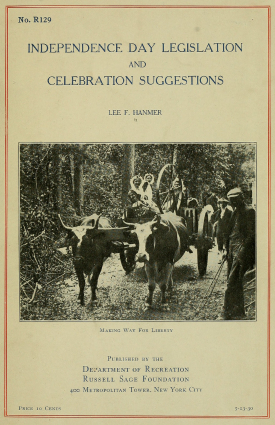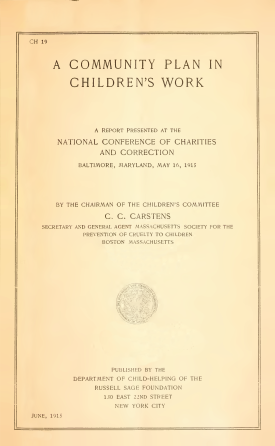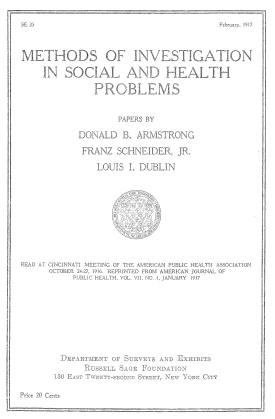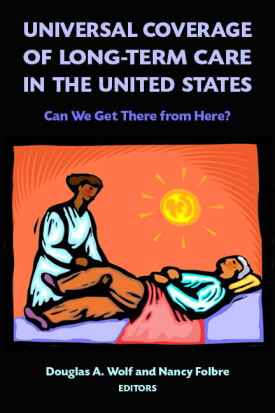
Independence Day Legislation and Celebration Suggestions
About This Book
Reports published by the foundation's Department of Recreation in 1913.
LEE F. HANMER was associate director of the Department of Child Hygiene at the Russell Sage Foundation.

Reports published by the foundation's Department of Recreation in 1913.
LEE F. HANMER was associate director of the Department of Child Hygiene at the Russell Sage Foundation.
This pamphlet argues for definite measurements of results in the study of school hygiene and other areas in order to improve the school system. It was published by the Department of Child Hygiene of the Russell Sage Foundation in 1911.
LUTHER H. GULICK was director of the Department of Child Hygiene at the Russell Sage Foundation.
A pamphlet published in 1910 by what was the Department of Child Hygiene of the Russell Sage Foundation. Other research areas of the Child Hygiene department included "folk dancing," "athletics," and the "use of school buildings."

An address presented at one of 47 different sessions of the Forty-Second National Conference of Charities and Correction, held in Baltimore for a week in May 1915.
C. C. CARSTENS was secretary and general agent of the Massachusetts Society for the Prevention of Cruelty to Children.
Published in 1910, this book presents the essential features and a brief history of the open-air school, a new type of schooling held almost entirely in the open air, with education focusing on outdoor life.
LEONARD P. AYRES was director of the Division of Education at the Russell Sage Foundation.
A 1911 survey of state legislation requiring medical inspections for schools and institutions.
LEONARD P. AYRES was director of the Division of Education at the Russell Sage Foundation.
Laggards in Our Schools presents the findings of a 1907 study on disabled children and the effects of education on their early years. The study analyzed the specifics of the children’s’ conditions and what factors caused them to drop behind in school, as well as to what extent attendance, homework, and other methods affected progress.
LEONARD P. AYRES was director of the Division of Education at the Russell Sage Foundation.

Three papers were read at a meeting of the American Public Health Association in 1916. They report on the lack of statistical evidence and analysis in health investigations, and why the statistical method is such a necessary element in public health research.
DONALD ARMSTRONG was executive officer of the Community Health and Tuberculosis Demonstration and assistant secretary of the National Association for the Study and Prevention of Tuberculosis.
FRANZ SCHNEIDER, JR. was sanitarian at the Department of Surveys and Exhibits of the Russell Sage Foundation.
LOUIS I. DUBLIN was statistician at the Metropolitan Life Insurance Company.
A growing literature has documented the ways that racial inequalities in wealth, health, and access to credit have threatened the stability of homeownership during the recent housing crisis and prior to it. Reverse mortgages, which allow older homeowners to covert home equity into cash in return for the lender receiving the home at the time of their death, are an understudied component of the housing landscape. Racially-stratified wealth and health vulnerabilities may shape decisions surrounding reverse mortgages, as well as the risks and benefits of this loan option.

As millions of baby boomers retire and age in the coming years, more American families will confront difficult choices about the long-term care of their loved ones. The swelling ranks of the disabled and elderly who need such support—including home care, adult day care, or a nursing home stay—must often interact with a strained, inequitable and expensive system. How will American society and policy adapt to this demographic transition?
In Universal Coverage of Long-Term Care in the United States, editors Nancy Folbre and Douglas Wolf and an acclaimed group of care researchers offers a much-needed assessment of current U.S. long-term care policies, the problems facing more comprehensive reform, and what can be learned from other countries facing similar care demands. After the high-profile suspension of the Obama Administration’s public long-term insurance program in 2011, this volume, the Foundation’s first free e-book, includes concrete suggestions for moving policy toward a more affordable and universal long-term care coverage in America.
David Bell is a Professor of Economics in the Stirling Management School at the University of Stirling, Stirling, Scotland.
Alison Bowes is a Professor in the School of Applied Social Science at the University of Stirling, Stirling, Scotland.
Leonard Burman is the Daniel P. Moynihan Professor of Public Affairs in the Maxwell School of Citizenship and Public Affairs of Syracuse University, Syracuse, New York.
Brian Burwell is Vice President for Community Living Systems at Thomson Reuters, Cambridge, Massachusetts.
Marc A. Cohen is Chief Research and Development Officer of LifePlans, Inc., in Waltham, Massachusetts.
Svein Olav Daatland is Senior Researcher at NOVA/Norwegian Social Research, in Oslo, Norway.
Nancy Folbre is a Professor of Economics at the University of Massachusetts at Amherst.
Mary Jo Gibson, formerly a Strategic Policy Adviser at AARP's Public Policy Institute, is a long-term care consultant.
Howard Gleckman is a Resident Fellow at The Urban Institute, where he is affiliated with both the Tax Policy Center and the Program on Retirement Policy.
Robert Hudson is Professor and Chair of Social Welfare Policy in Boston University’s School of Social Work.
Carol Levine is Director of the Families and Health Project at the United Hospital Fund, New York City.
David Stevenson is an Associate Professor of Health Policy in the Department of Health Care Policy at Harvard Medical School.
Robyn Stone is Executive Director of the Center for Applied Research and Senior Vice President of LeadingAge in Washington, D.C.
Eileen J. Tell is Senior Vice President of Univita (formerly the Long Term Care Group, Inc.), in Natick, Massachusetts.
Douglas Wolf is the Gerald B. Cramer Professor of Aging Studies and Director of the Center for Aging and Policy Studies at Syracuse
Robyn I. Stone discusses the long-term care workforce in America, its challenges and potential reforms for improvement. Read the Interview
Carol Levine discusses her personal experience as a family caregiver, and how policy must change to better support friends and family who offer unpaid care. Read the Interview
Douglas Wolf offers an overview of Universal Coverage and outlines possible reforms to improve the provision of long-term care in America. Read the Interview